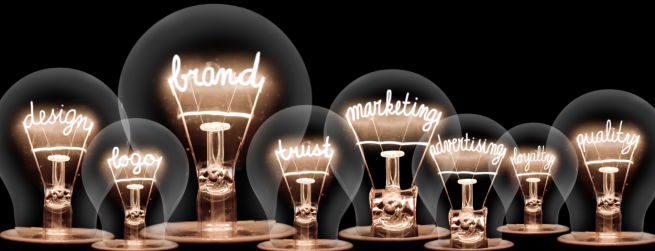What’s the best marketing tool to help differentiate your business so your customers can easily recognize it in a crowded marketplace?
It’s your brand identity and how you communicate as a brand.
Developing a strong, memorable brand identity involves creating a logo that symbolizes your company, but that’s just one step in the process. Your brand should also have a name, tagline, and design. But your brand identity also defines your brand voice and includes:
- How you communicate as a brand and how you want to make people feel.
- Your business personality and how it distinguishes your company from competitors.
- The values of your business and the promise you make to your customers.
Why Brand Identity Is So Important
Consider these wise words from HubSpot: “Ultimately, your [business] leaves an impression on your customers long after you've made the sale. Brand identity is the process of shaping that impression.”
It’s crucial to understand brand identity as a process that can drive the future success of your business. If your brand is unique and memorable, you’re likely gaining recognition in the marketplace as a result. If you are consistently inspiring prospects to convert to customers, you’re likely building a strong loyalty to your brand.
To do all this, or if your brand is broken, your brand identity needs continuous care and attention in order to stand out among so many others.
3 Things You Can Do To Make Your Brand More Recognizable
- Define your path to differentiation.
PricewaterhouseCoopers (PwC) uses this framework to help you assess your company’s current performance in terms of operations and brand strategy effectiveness:
- Operations include product offering, strategic pricing, digital engagement, loyalty programs, omnichannel experience, and supply chain.
- Brand strategy includes identity, value, perception, and awareness.
Rank all the aspects of both operations and brand strategy using a scale of one to four:
- One equals basic capabilities.
- Four equals differentiated capabilities.
Based on the rankings, your company can fall into one of these four groups: Hopefuls, Doers, Visionaries, and Differentiators.
For instance, if your business ranks a three or four in at least two operational components and all of the brand strategy components, you can consider yourself a Differentiator. Differentiators have both effective operations and strategy. To stay on top, Differentiators should focus on strategic growth through innovation, prudent partnerships, and tactical alliances.
Hopefuls need both effective operations and strong brand strategy. Hopefuls should focus on defining the right brand identity first: what they represent, the value they bring to the market, and how they are unique from their competitors.
Doers have effective operations and need a better brand strategy that is ultimately capabilities-driven. Doers should leverage their competitive advantage as a differentiator.
Visionaries have a unique brand strategy but need their operations to catch up. As a result, Visionaries should focus on growing operational capabilities to expedite their strategy successfully.
Depending on your group, you can determine the best process to make your brand more recognizable.
- Honor the customer experience.
Over the years, convincing data has been gathered in support of the customer experience and its importance for a highly recognizable brand. A recent survey finds that 73% of customers use their experience with a business as an important influencer in their purchasing decisions. The survey also finds that customers are willing to pay as much as a 16% price premium for a superior customer experience, and are more likely to stay loyal to the brand that offers it.
Making sure your business can connect to your customers and provide the best customer experience possible is another way to make your brand more recognizable. This means developing a brand strategy based on operational excellence and focusing on what makes for a good customer experience. At the very least, studies show that over 70% of consumers consider speed, convenience, helpful employees, and friendly service the must-dos of a good customer experience.
It's also a good idea to stay up-to-date on consumer trends. The Global Consumer Insights Pulse Survey from PwC is a great place to start.
- Develop a Voice and Tone Guide.
A voice and tone guide is a living document that defines your brand identity and explains how your business communicates as a brand. You can think of it as a shorthand communiqué for your entire business. Brand Voice represents your brand’s overall personality, its unique perspective, and the values it stands for. Brand Tone is how your brand chooses to communicate. This can be adjusted based on what is most appropriate for the situation at hand.
Voice and tone guides usually deal with these five things that comprise a well-developed brand identity. They include:
- A logo – an iconic image that instantly translates to or brings to mind the name of your company.
- That sense of credibility and trust – what makes your business an authority in the market.
- A template for marketing impressions – the information included in an ad for your business, no matter where it appears.
- An expression of your company’s purpose – which is often in the form of a stated company mission.
- The way you generate new customers and brand advocates – as they say in the biz, “A good product generates customers, but a good brand generates advocates.”
Voice and tone guides are comprehensive, offering useful information about your target audience, value proposition, and competition. They will include a list of do’s and don’ts as well as ways to monitor and maintain your brand identity. There’s often a list of things to avoid, such as:
- Avoid giving mixed messages to your customers.
- Avoid copying your competitors.
- Avoid inconsistency at all costs. Make sure your digital presence matches your physical one artistically and in type, theme, and message.
A voice and tone guide is especially effective for ensuring your brand provides quality content for your ideal customers. Why? Because it defines the language your brand uses to advertise your products and services and to connect with your audience:
- Language should match your brand’s personality.
- The use of storytelling provides connection, especially emotional connection.
- Advertising messages should also reflect your brand’s mission and personality.
- All messaging should remain consistent among media, whether digital or non-digital, online or offline, traditional media or social media.
11outof11 Knows Brand Identity
When you’re ready to develop a voice and tone guide for your brand identity, connect with 11outof11. Request a complimentary call with an 11outof11 expert. Contact us to learn more.







.png)






